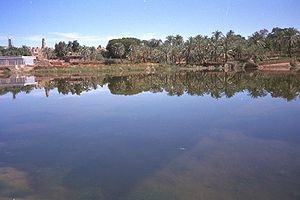Dakhla Oasis
| Dakhla Oasis | |
|---|---|
| Oasis | |

Dakhla Oasis, February 1988.
|
|
| Nickname(s): Inner oasis | |
| Location in Egypt | |
| Coordinates: 25°29′29.6″N 28°58′45.2″E / 25.491556°N 28.979222°E | |
| Country | Egypt |
| Governorate | New Valley Governorate |
| Area | |
| • Total | 2,000 km2 (800 sq mi) |
| • Land | 1,500 km2 (600 sq mi) |
| Population (2002) | |
| • Total | 75,000 |
| • Ethnicities |
Egyptians Ottomans (Qalamoun) |
| Time zone | EST (UTC+2) |
| Capital | 'Ain Basil (Balat) (c. 2500 BCE-c. 1500 BCE) Mut (c. 1500 BCE- ) |
Dakhla Oasis (Egyptian Arabic: الداخلة El Daḵla , pronounced [edˈdæxlæ]), translates to the inner oasis, is one of the seven oases of Egypt's Western Desert. Dakhla Oasis lies in the New Valley Governorate, 350 km (220 mi.) from the Nile and between the oases of Farafra and Kharga. It measures approximately 80 km (50 mi) from east to west and 25 km (16 mi) from north to south.
The human history of this oasis started during the , when nomadic tribes settled sometimes there, in a time when the Sahara climate was wetter and where humans could have access to lakes and marshes. But about 6,000 years ago, the entire Sahara became drier, changing progressively into a hyper-arid desert (with less than 50 mm of rain per year). However, specialists think that nomadic hunter-gatherers began to settle almost permanently in the oasis of Dakhleh in the period of the Holocene (about 12,000 years ago), during new, but rare episodes of wetter times.
In fact, the drier climate didn't mean that there was more water than today in what is now known as the Western Desert. The south of the Libyan Desert has the most important supply of subterranean water in the world through the Nubian Aquifer, and the first inhabitants of the Dakhla Oasis had access to surface water sources. In the third millennium BC lived here people that were most likely nomads and are called the Sheikh Muftah culture.
The first contacts between the pharaonic power and the oases started around 2550 BCE.
During the late 6th Dynasty, hieratic script was sometimes incised into clay tablets with a stylus, similar to cuneiform. About five hundred such tablets have been discovered in the governor's palace at Ayn Asil (Balat) in the Dakhla Oasis. At the time the tablets were made, Dakhla was located far from centers of papyrus production. These tablets record inventories, name-lists, accounts, and approximately fifty letters.
...
Wikipedia

